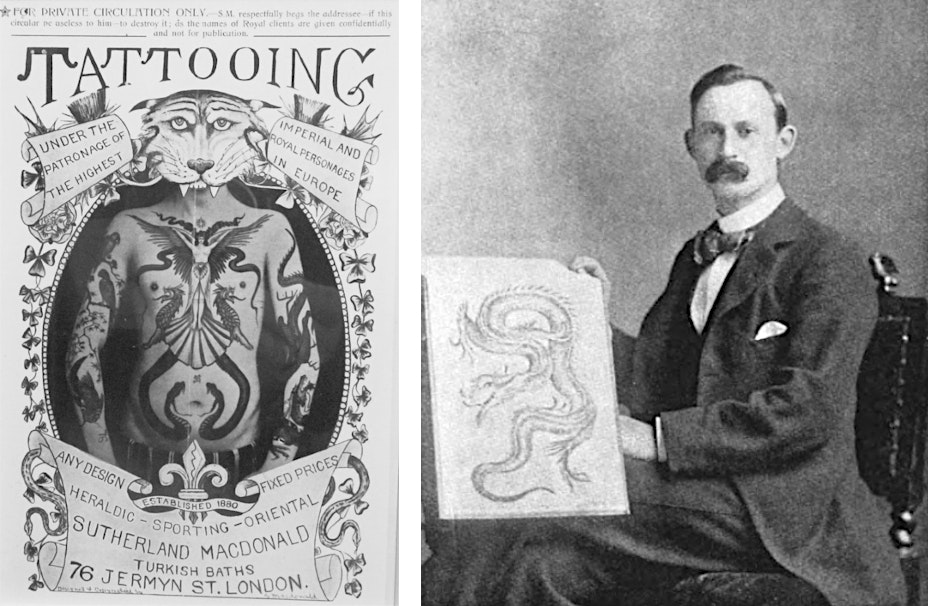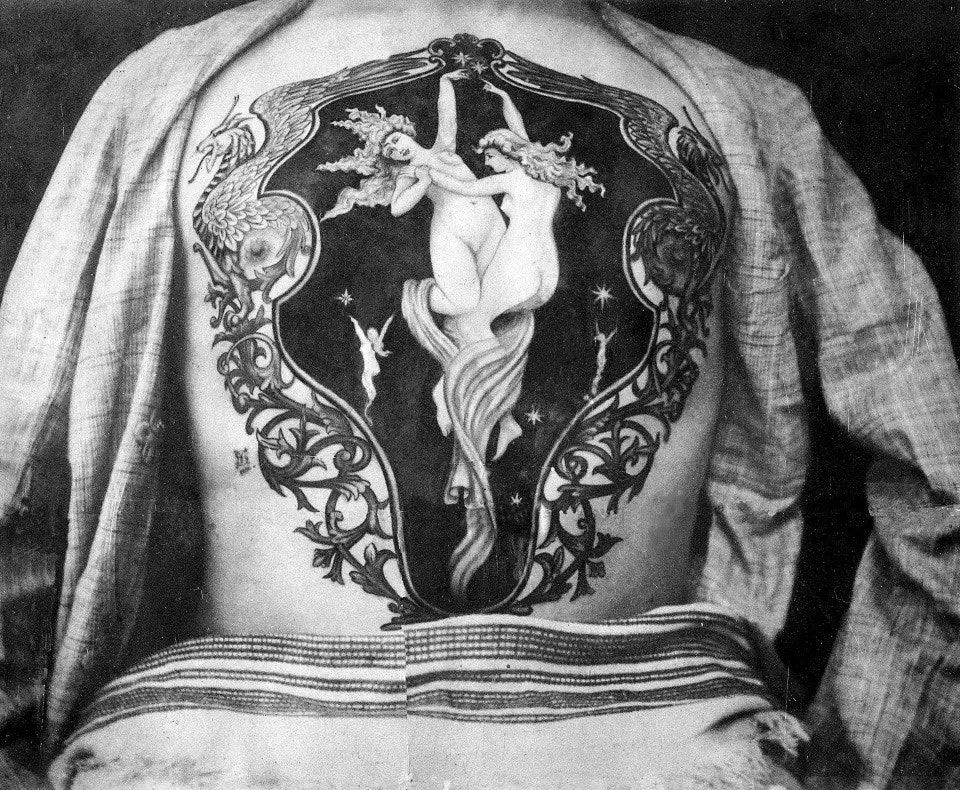
The Art of Sutherland Macdonald, Victorian England’s “Michelangelo of Tattooing” (ca. 1905)
It’s an era when tattoos are no longer taboo: men and women flock to a London studio to enjoy cooling drinks, a snug stove, and the steady hum of a modern electromagnetic machine, fitted with interchangeable needles for fine lines and shading. Inked on their skin are designs “gathered from all corners of the globe” — Japanese dragons, The Last Supper, a fox hunt in full cry — and words from Arabic, Burmese, and other tongues. Snakes, lizards, and frogs are a current vogue. Coloration has come a long way since the early days: ultramarine blue and emerald green, once thought impossible, are now shot freely into the dermis. Officers get their regimental badges emblazoned; “some of our best-known society men” proudly sport a patch or crest. “Tired of constantly rouging her cheeks”, a woman stops by for the application of permanent makeup. It’s truly a tattoo enthusiast’s paradise . . . Sutherland Macdonald’s studio in Victorian England.
“It is no exaggeration to say that tens of thousands of men and even women are more or less decorated in this manner at the present moment”, writes Gambier Bolton in “Pictures on the Human Skin”, an 1897 article for London’s Strand Magazine from which the above descriptions are drawn. (A year later, R. J. Stephens would put the number of tattooed at 100,000 in London alone.) Bolton goes on to describe the current loci of artistic tattooing: “England, America, Burmah, and Japan”, and posits that Britain’s fascination with inked skin stretches back to before the Norman Conquest, when tattooing was “universally” practiced on the Isles. To illustrate his article, he begins with a coat of arms design by Sutherland Macdonald, the first British tattoo artist to open a public studio, “The Hammam” on Jermyn Street in London. “No one in the past, and no man living to-day, can compare with Macdonald in placing really artistic pictures on the human skin.”
 Scroll through the whole page to download all images before printing.
Scroll through the whole page to download all images before printing.The photographs of Macdonald’s artworks, collected below, are records from the Copyright Office at Stationers' Hall, and perhaps relate to a service detailed by Bolton: “in more than one instance the copyright of some particularly striking image has actually been purchased outright, so no one but the wealthier patrons of the Jermyn Street studio shall have the use of them.” (This seems to have been the case with a tattoo of Psyche and Amour on the back of one Captain Studdy, whose copyright is registered to Macdonald.) During the late 1800s, tattoos became a fixation for the upper classes; as Macdonald himself remarked in an 1889 interview in the Pall Mall Gazette: “I have tattooed many noblemen, and also several ladies.” Scholars occasionally attribute the shifting class connotations of tattoos to Albert Edward, Prince of Wales — his decision to get marked while visiting the Jordan River and, later, to have his sons supposedly tattooed in Japan by Hori Chiyo, Macdonald’s competitor on the international stage. Describing tattooing as “the popular pastime of the leisured world” in an 1898 article titled “Tattooed Royalty”, R. J. Stephens named just a few of the majestically inked — Grand Duke Alexis of Russia, Prince and Princess Waldemar of Denmark, Queen Olga of Greece, King Oscar of Sweden, the Duke of York, the Grand Duke Constantine, Lady Randolph Churchill — many tattooed by Macdonald himself.
Part of Macdonald’s genius was his ability to court wealth by elevating the status of his artform. Earlier in the nineteenth century, tattoos were shadow signs — encountered on the bodies of sailors, soldiers, and recidivists, occasionally described in medical literature or criminology handbooks, but largely obscured from public discourse. Macdonald changed these perceptions by wearing a white coat (emulating a medical professional), using the latest technologies (he is credited with inventing the first electromagnetic tattoo machine), operating in proximity to a popular Turkish bath (playing up fashionable orientalism with a studio full of luxurious cushions), and registering a legitimate practice in the Post Office Directory (necessitating the creation of a new category of business). He cunningly referred to himself as a tattooist, distinguished from the workaday tattooer: “He lays great stress on the ‘IST’”, writes Bolton, “as he classes the ‘ER,” with the plumber and bricklayer, whilst the work of the tattooist, he claims, should rank with the professions”. By 1900, L’Illustration had named Macdonald “the Michelangelo of tattooing”. The photographs below can only hint at the depth of color and nuanced texture that admirers attributed to his works.
Mar 12, 2024









